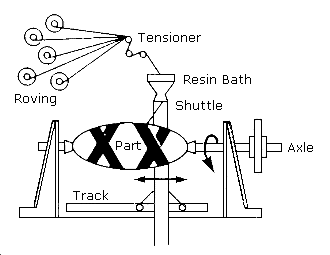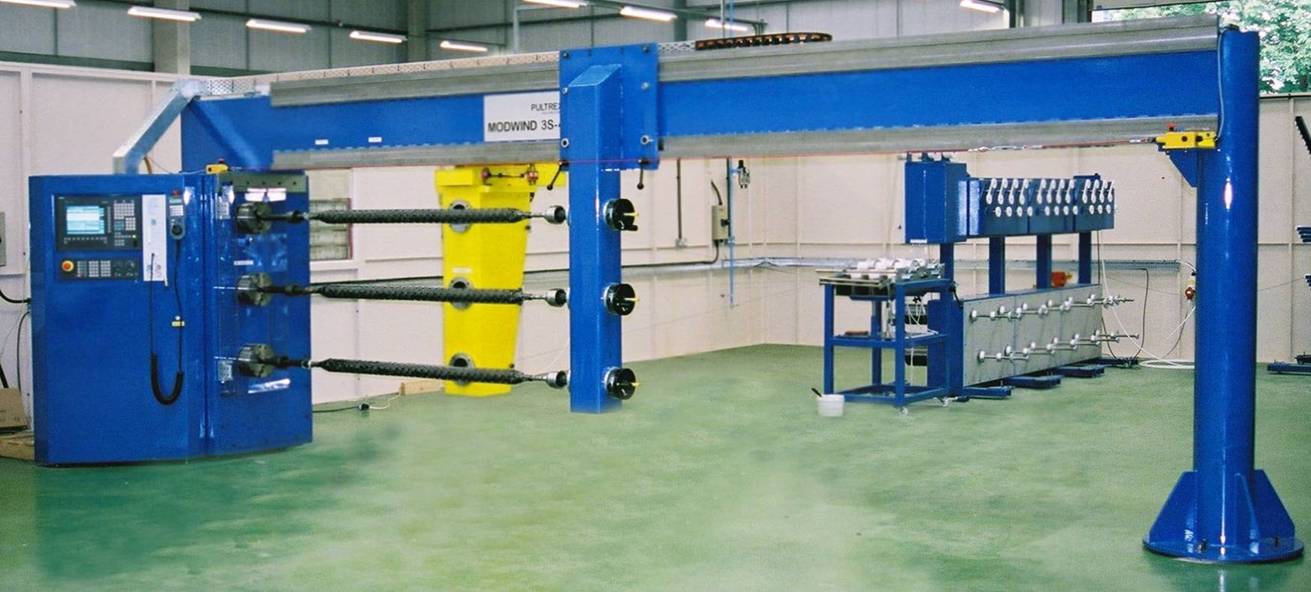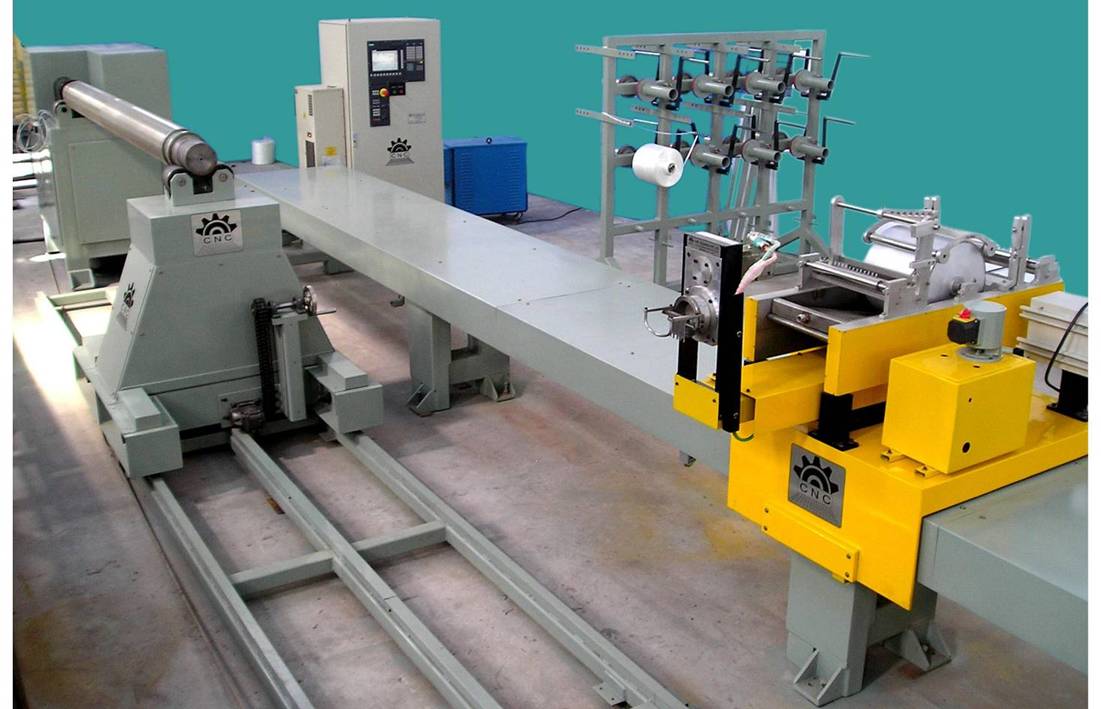Filament Winding Process Overview
Filament winding is an automated method for creating composite structures by winding filaments under tension over a rotating mandrel (tool). The fibre placement is guided by a machine with two or more axes of motion, as can be seen in the simple schematic diagram below. Filament winding a used to manufacture a range of products such as pipes, pipe joints, drive shafts, masts, pressure vessels, storage tanks etc. There are a number of different types of filament winding machine that are best suited to manufacturing different type of components


Filament Winding Machines
The simplest winding machines have two axes of motion, the mandrel rotation and the carriage travel (usually horizontal). Two-axis machines are best suited to the manufacture of pipes only. For pressure vessels such as LPG or CNG containers (for example) it is normal to have a four-axis winding machine. A four-axis machine additionally has a radial (cross-feed) axis perpendicular to carriage travel and a rotating fibre payout head mounted to the cross-feed axis. The payout head rotation can be used to stop the fibre band twisting and thus varying in width during winding.
Machines with more than four axes can be used for advanced applications, six-axis winding machines usually have 3 linear and 3 rotation axes. Machines with more than 2 axes of motion have computer/CNC control, however these days new 2-axis machines mostly have numeric control. Computer controlled filament winding machines require the use of software to generate the winding patterns and machine paths, such software can normally be provided by filament winding machine manufacturers or by using independent products such as Cadfil. The Cadfil software can be configured for any computer controlled filament winding machine and also for general purpose 6-axis robots with minor adaptions for filament winding.
Cadfil is supplied configured for the customer’s winding machine. Cadfil can be supplied with multiple machine configurations, the user just selects which machine to use. Cadfil can be configured for 2 to 6 axes and for all filament winding machines types and control systems.

Advantages of Filament Winding.
Filament winding is one of the few Automated Processes for composites manufacture and can thus produce highly repeatable, high quality components at reduced labour content. It is quick and reliable technology for making high performance parts. A big advantage of filament winding is that it used continuous fibres which leads to very good material properties for both strength and stiffness. There is also the ability to orientate fibre direction for ‘optimised’ composites. High Fibre volume fractions are possible 60-80% and it can use materials in the simplest (lowest cost) form - Fibre Roving & Resin Winding is accurate, repeatable and gives a high quality internal surface.
Can use all fibre types: E Glass, S-Glass, R-Glass High Strength & High Modulus Carbon Fibre Aramid (Kevlar) HD Polyethylene (Spectra/ Dyneema) Basaltic Fibres Organic (e.g. Hemp Fibre) Esoteric Aerospace Materials ( e.g. Alumina , Silicon Carbide, Boron)
Can use a wind range of matrix (resin) groups: Polyester (versatile ‘best’ cost) Vinyl-ester (improved strength & impact/chemical resistance Epoxy (high strength and higher temperature capability) Phenolic (better fire resistance / low smoke) Bismaleimides (BMI) – higher temperature than epoxies) Thermoplastic matrix - normally in tape form comingled with the fibre
History of the Filament Winding Machine
Early 1960s - First Commercial Winding Machines These machines were cumbersome, mechanical equipment requiring changes to gears, and belts / chains in order to alter a wind angle or wind length, and were mainly used for tubes. Special machines were developed for pressure vessels, including ‘tumble’ winder & polar (spherical) winders. Late 1970s – First computer controlled winding machines. Not very reliable and difficult to program, programming methods were a mixture of calculation, trial & error and ‘teach-in. Early 1980s – First CNC winding machines. Control technology was developing rapidly from companies like Bosch, Fanuc, NUM & Siemens. These control systems were focused on metal cutting (Milling and Turning) but being general purpose could be used for filament winding. The need for improved programming methods to take advantage of the new technology was clear.
Development of Cadfil - some history!
University of Nottingham UK, 1976-1986: During this time there were numerous research projects into many aspects of filament winding under Mike Owen (Professor of Reinforced Plastics) & Vic Middleton (Professor of Mechanical Engineering). In 1981 the composites department acquired a 5 axis CNC winding machine and considerable focus was put on exploring the capabilities of winding and developing programming techniques on VAX computer hardware.
1983 – Crescent Consultants Formed: Owen & Middleton formed a private limited company to exploit (under licence) some of the winding technology being developed at the University. The software was converted to run on the IBM PC and was branded under the CADFIL trademark, Computer Aided Design for FILament winding.
1984 – First CADFIL sale: CADFIL was the first independently available off-line programming system of filament winding. Running on an IBM PC with MS-DOS it featured a graphical user interface
TODAY – Continuous Development: More than 30 years after its inception CADFIL is the worlds leading winding software working on the latest Windows systems and is subject to continuous development to meet the changing needs of our global customer base.
Filament Winding Today
Filament Winding is a mature Technology Machines are now becoming standardised and have lower cost. They are now being used in companies of all sizes and are no longer the preserve of defence, aerospace and corporate R&D centres. The main machine types are:
